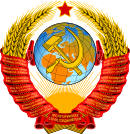This article has multiple issues. Please help improve it or discuss these issues on the talk page. (Learn how and when to remove these messages)
|
| Part of a series on the |
| Culture of the Soviet Union |
|---|
 |
| People |
| Languages |
| Traditions |
| Cuisine |
| Festivals |
| Literature |
| Music |
| Sport |
The Sixtiers (Russian: Шестидесятники, romanized: Shestydesiatnyky, Ukrainian: Шістдесятники, romanized: Shistdesiatnyky; "people of the 60s") were representatives of а new generation of the Soviet Intelligentsia, who entered the cultural and political life of the USSR during the late 1950s and 1960s, after the Khrushchev Thaw.[1] Most of them were born between 1925 and 1945, and their worldviews were formed by years of Stalin's repressions and purges, which affected many of the Sixtiers' immediate families, and World War II, in which many of them had volunteered to fight.
The Sixtiers were distinguished by their liberal and anti-totalitarian views, and romanticism, which found vivid expressions in music and visual arts. Although most of the Sixtiers believed in Communist ideals, they had come to be strongly disappointed with Stalin's regime and its repression of basic civil liberties.
The Sixtiers can be roughly divided into two groups: the "physicists" (those involved in sciences) and the "lyricists" (those involved in arts, such as writers, theatre and film professionals, etc.). Among some of the common attributes and pastimes of the Sixtiers were Bard (singer-songwriter) music, poetry, disillusionment in politics, and love for camping trips to remote regions of the USSR.
After the beginning of the Perestroika and Glasnost policies (in the late 1980s – early 1990s), the term "Sixtiers" was also used to denote the representatives of the new generation of communist elites whose political views were formed in the late 1950s – early 1960s. These include politicians M. Gorbachev, O. Yakovlev, philosophers A. Zinoviev, M. Mamardashvili, Y. Levada, political scientists A. Bovin, F. Burlatsky, mass media editors V. Korotych, E. Yakovlev, S. Zalygin, poets Boris Slutsky, Robert Rozhdestvensky, Andrei Voznesensky, Yevgeny Yevtushenko, Alexander Kushner, Victor Sosnora, Bella Akhmadulina, Yunna Morits, Oleg Chukhontsev, dramatist Alexander Vampilov. and many others.
Some parallels can be drawn between the Sixtiers and the New Left and hippie movements in the West, but even closer similarities can be found with the more intellectual-oriented Beat Generation.[1]
- ^ a b Удовенко, Олександр. "The Ukrainian Sixtiers Dissident Movement Museum". Музей історії міста Києва. Retrieved 2022-05-02.